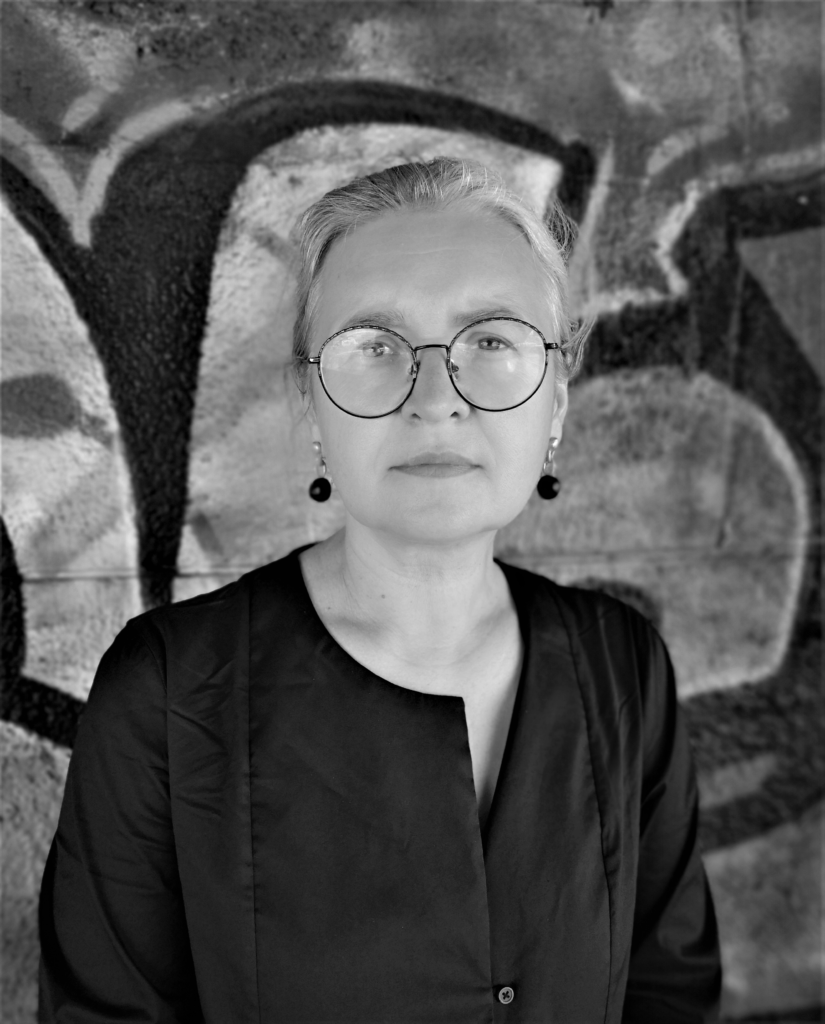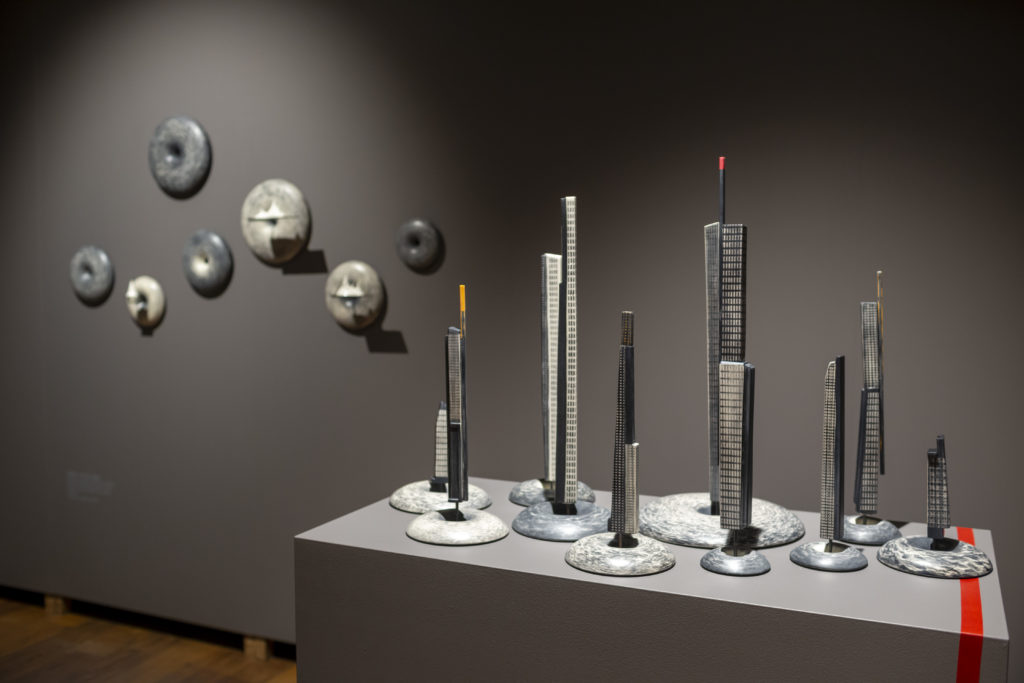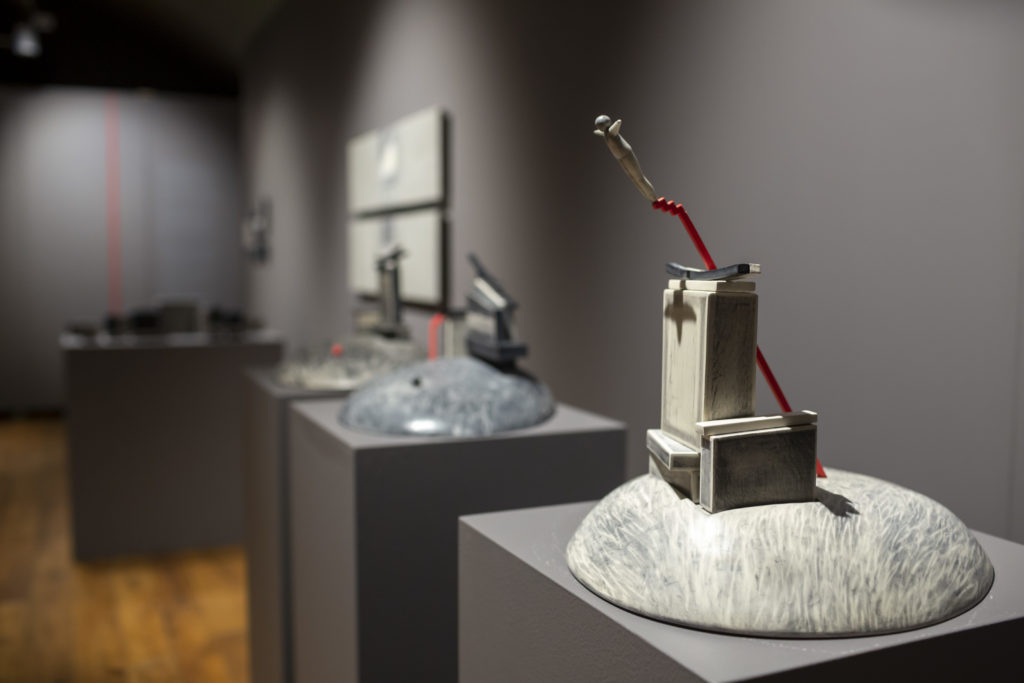Hallway talks with Milena Pirštelienė (Lithuania)

The Rothko Centre: Your creative style, did you settle on it right away?
Milena Pirštilienė: It’s been ages since I finished the Academy. More than 20 years. That’s when Lithuania was regaining independence. Basically, we graduated into nothingness and had to decide what to do with our baggage of knowledge. I kept up the ceramics, but my exhibition life was sporadic, to say the least. Let’s face it – ceramicists spend lots of time making dishes. They do applied art and find a compromise, acknowledging that fine art and applied art are connected. But then I got bored. I realised I would have to change my nature or stop doing it altogether. At the Academy, my style had been totally different. I was young and leaned towards pop art. And when you come back to serious work, you no longer know who you are. You need to start looking from scratch. So I had to find my technique. After all, ceramics offers vast possibilities. With porcelain, you get one thing, with high fire or rougher materials – something else entirely. And I’ve always liked photographic drawing. But there was no way to learn it at the Academy, they didn’t have the programme. So I tried different techniques – porcelain, different firings… But I couldn’t stop thinking it wasn’t me. And then, seven-eight years ago, I was preparing for a group exhibition and tried drawing with pigment. It took me one and a half months to finish one piece (in ceramics, you start by experimenting with firing and see what works, so it’s very time-consuming). That’s when I knew I’d found what I really love in ceramics. And I just kept going. My style was found. So my background in ceramics is quite long, just not in this particular direction.
RC: Can this style be perfected, or is it already set and self-sufficient, meaning you can go with the flow without trying to improve things?
MP: Of course, you can’t stop. You see, I’ve just started drawing water, and with that came the doubt – will I manage? I was sure I’d fail! I’m a ceramicist, not a draftswoman. I don’t have the skill to draw water. But I thought I’d give it a go. For three days, I sat there, drawing and erasing, drawing and erasing… And suddenly, something clicked, and I knew I’d got it. The first piece in this style is the sea horizon. I was doing it, and I kept telling myself – no pressure, no hurry. So I’d come to the studio, put some music on and start drawing. Not working? Never mind. I’d come another day. This is how you chance upon new things, and every such thing is a bridge to the next step.
RC: Do you love water?
MP: I’m afraid of it. And my nightmares are all to do with water. I see myself drowning. And I’m not swimming, I’m drowning, totally, the house and all. It’s terrible, the worst thing ever (laughs). And I don’t know where that comes from. I really don’t. I must have drowned in my previous life. For me, water is a magical substance. Transparent and shapeless. It’s there and also not… So amazing and so illogical. And it’s everywhere! We, too, are made of water… so odd. I’d never have thought it if not for my dreams. Actually, I often wonder why artists choose this and not that as their theme. It’s amazing – if something touches your subconscious, you know that’s what’s really bothering you. It’s beyond your understanding. It can’t be explained.
We’re surrounded by things that can’t be explained. Take imagination – some people have it, others not. Or an ear for music – some can hear when you sing off tune, others can’t. Some see colour, others – very little. And when you find what’s yours, the thing you’re good at, you see you’ve not wasted your time looking. You know, it’s not uncommon for artists to grapple with this terrible question – what am I doing?… Ability to create beauty is a talent. Like an ear for music. It’s a gift. Not everyone has it. You also need to be actively present and engaged.

RC: Some artists try to manipulate the public. What’s your view on provocative art?
MP: Naturally, provocative, controversial art has its place. Sometimes it’s deliberately disgusting to cause revulsion. Then there’s the art that de-emphasises the visual and makes you think. There’s nothing classical about it. I recently saw an exhibition about video games. For me, it was a world unknown. I didn’t understand a thing! (laughs) I kept wondering around, gazing at the objects, and it made me think about hearing a foreign language you don’t know. Even wall texts did little to help. Yes, there are universal things that everybody gets. But there are also some very narrow and specific niche topics… It was so weird – you’re desperate to understand, and you just can’t! (laughs)
RC: What emotions do you secretly want to evoke in your viewer?
MP: Oh, this is a tough one. I guess I’m focused mainly on what I care about. I’ve concluded that we get excited about art we understand. Art that touches on our experience. Why do some people cry when they see art while others don’t get it, thinking – what’s all the fuss? I guess that’s because we find ourselves in these works. And it’s important to know you’re not alone. That there are others who feel like you do, who experience the same things. It’s such an emotional moment, to see you have kindred spirits (smiles).
RC: Your subjects, are they real or imagined?
MP: It depends. Our imagination is phenomenal. Things look so much better and mysterious in our heads. There, everything is moving. Here you have just a pale reflection. Idea turned matter, with all its limitations. In my head, things are way more spectacular (laughs).
RC: Where do you get the themes?
MP: They can be triggered by chance. Sometimes I make sketches; other times, I get straight to work and improve things later. Then I feel I’ve finally caught something by the tail… and I start developing it. Take the concept of time. How do you show it? How do you express it in ceramics? And I thought about round shapes, like circles on the water. Moments. The power of the moment. I make my own language of symbols.
RC: Do you have a long-cherished idea that you can’t get round to doing?
MP: I have this memory of when I was little – I’m sick in bed, and I’m looking at my blankets and pillows, but what I see is mountains and landscapes… That was my imagination. Children have this capacity – to see large things in something small, to lay in bed and imagine. Draw imaginary worlds from what they see. I want to create from these impressions. I never know it’ll work (laughs). But something from this childish ability to observe has stuck. For instance, I often see faces in wood texture. There’s a wooden door in one of the churches in Vilnius, and I see a devil there! And I keep wondering – do people really not see it? So weird. (bursts out laughing)
RC: Do you do commissions?
MP: For me, it’s simple – if I don’t have my own projects, I can easily go into my studio and make a vase. Ceramics is a very haptic and pleasant experience. And I enjoy the process. I don’t see it as work. Preparing an exhibition isn’t work either. You don’t always want something intricate and complex. There are times when you want life to be easy. So you go and make a vase (bursts out laughing).
RC: But surely, this ease is deceptive. What’s behind it?
MP: Well, everything needs to be right in terms of technique and professionalism. You need skills. To get one really good vase, you need to make a hundred bad ones. But that’s also experience. After all, we work with a very complex material. I don’t know why, but the world seems to be flooded with applied ceramics. Like those one euro mugs. And since they’re so many, they seem worthless. In fact, even large production plants invest lots of effort – someone drew the sketch, someone else worked on the colour scheme, and then there’s technology. But this ‘behind-the-scenes’ part is invisible, so people don’t see its value. You know, we, clay artists, have a love-and-hate relationship with out material. Imagine you’re firing your piece, you’ve worked on it for so long, put in so much effort, and it just goes and cracks… And you’re desolate (laughs). Tough, isn’t it. You’ve miscalculated, misjudged, so this is what you get… That’s why ceramicists need to be very careful and factor in multiple variables to get the result that they want. So it’s no big deal, no heroic feat to simply make the piece. You need to make it and then give it up to the flames, those incredible temperatures, and if it’s all good after firing, well done, you’ve hit the mark.
My process is very slow, always. The people who see my exhibition will probably think – oh, this must have been easy and quick, no big deal. In fact, these works (the artist’s solo show ‘Water’ at the Mark Rothko Art Centre – ed. note) are the culmination of three to four years of effort. So I go for quality. If you can’t make large-scale objects, you go small but aim for quality.

RC: Who are your favourite artists?
MP: I’m like a sponge – I soak everything up. Naturally, I have my preferences. When I travel with my husband, we always visit galleries and art spaces, we go places, see things and get inspired. We’ve been to Italy. And you’d think you can’t fall in love with Renaissance all over again, there’s got to be an end to it. But once again, I was blown away… This impossible beauty. It’s unreal! How do you even do it? When I don’t have the chance to go and see the classics, I dive into contemporary conceptual art. I was recently impressed by a gallery show where the space was filled with fuel oil. My first question was purely technical – how have they done it? We’re not talking pans or bowls, the entire space was flooded. The ecological message screamed into your face, the halls were literally flooded in oil. With just a few balconies to stop and watch. And that terrible smell! I’ll be honest, it was as powerful as the Italian Renaissance. Oh, by the way, I also love Anish Kapoor and his installations.
RC: And is there anything that puts you off?
MP: There’s art that gets on my nerves. There comes a new trend, and everybody’s exploiting it. When I see the same stuff over and over again in every museum, it sends me up the wall. It’s good to see the pioneer, the original author who came up with the idea. But the rest has nothing to do with individualism and that special personal touch.
Today’s art tends to rely on extensive research. Not my thing. I know projects where women go to factories or a coffee plantation and work there, reporting on their progress. I’m not impressed.
There are a few reasons why such projects spread like fire. They talk ecology and consumerism. Some artists are honest in their appeal but for others, it’s just a fad.
RC: How do you think our time affects art and life in general?
MP: The world is changing. Fast! Ours is an age of clips and clicks… We’re losing depth. There’s heaps of negativity around, and it keeps growing. Go read a comments section online. It’s madness! What people write there is heartless. Are they even real? I don’t get it. I mean, are they’re really like that, or is it just an energy dump, their way to get rid of excess emotions. I’m afraid the world is getting nasty, and I’m not comfortable with that. I recently read a private journal of a Saint-Petersburg intellectual, written a hundred years ago. You know, I’d write the same things today, to the letter. People don’t change.
RC: What’s your philosophy? What do you believe in?
MP: If one door closes, another opens. Things will be different, but that’s not necessarily bad! We’re all boats in a river of opportunity. And that’s relaxing. If things don’t go one way, they’ll go another. I’m no fatalist, but that’s what experience tells me.
